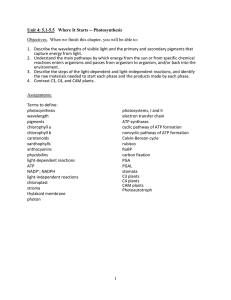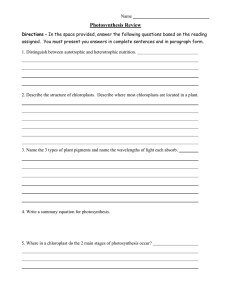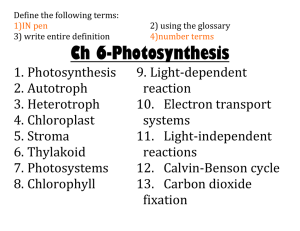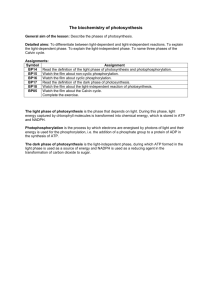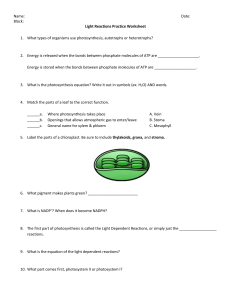Chapter 8: Energy and Photosynthesis
advertisement
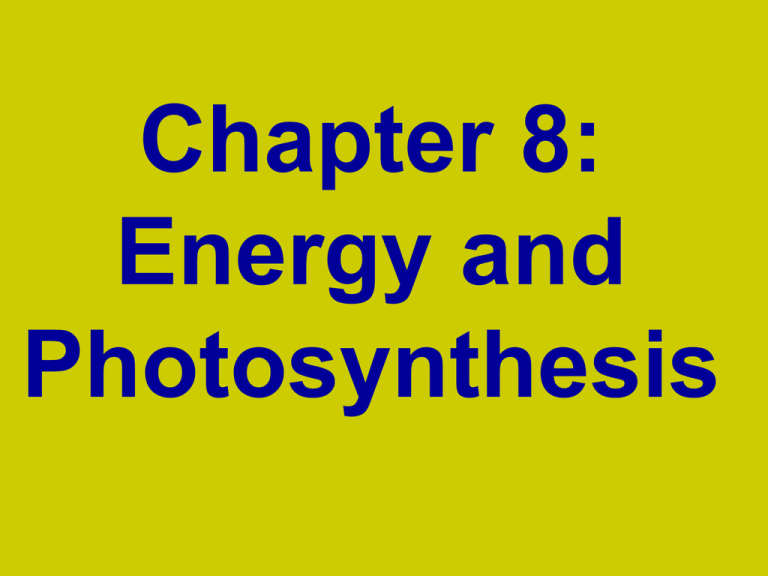
Chapter 8: Energy and Photosynthesis Energy and Photosynthesis • Energy is necessary for all life –Plants and green organisms: • Trap light energy in the form of sunlight and store it for later use –All other organisms: • Eat green plants to obtain energy Adenosine Triphosphate (ATP) • Energy molecule • Composed of: – Adenosine molecule – Ribose sugar – 3 phosphate groups • ATP becomes available for a cell to use when the bonds between the phosphate groups are broken – Releases energy when a phosphate group is removed – Bond breaks between the 2nd and 3rd phosphate groups • Results in adenosine diphosphate (ADP) • ATP is a small molecule – Stored energy (ex: a battery) • Cells use energy to maintain homeostasis Photosynthesis • Photo-: means light • Synthesis: to put together • Process that uses the sun’s energy to make simple sugars • 2 phases – Light-dependent reactions – Light-independent reactions History • Van Helmont (1600’s) – Planted seedling in pot of soil, watering it regularly – Concluded plant mass comes from the water • Priestley (1700’s) – Candle with glass jar cover flame died – Mint sprig and candle with glass jar cover flame burned – Conclusion: plants release oxygen • Ingenhous – Supported Priestley will occur only when mint plant is exposed to light Photosynthesis Requirements • Light (sun) • Carbon Dioxide (from the air) – Taken in to plants through little openings in the leaves called stomata • Water (from the ground) – Taken in through the roots of plants • Chlorophyll and enzymes in the plant • Rate of photosynthesis depends on: – The availability of sunlight, CO2, and H2O – The intensity (brightness) of light – Temperature (20-35º C is optimal) • White light mixture of different wavelengths of light – Visible spectrum ROYGBIV • Pigments: molecules that absorb specific wavelengths of sunlight – Ex: Chlorophyll (in chloroplasts): a and b • Absorbs well in blue and red light • Absorbs most wavelengths except green (reflects green light) • Makes plants appear green – Other plant pigments: • Xanthophyll: yellow pigment • Carotene: orange pigment • Equation: 6CO2 + 6H2O + light C6H12O6 + 6O2 Carbon Dioxide + Water Sugar + Oxygen gas • Chloroplast: cell organelle where photosynthesis occurs – Light-dependent reactions take place in the thylakoid membrane (contains pigments) • Picture of a chloroplast: – Grana: stack of thylakoids – Stroma: outside of the thylakoids – Photosystem: clusters of pigment and protein that absorb light energy (found in thylakoids) Review: 1. Match the scientist with the appropriate experiment or conclusion: Priestley van Helmont Ingenhousz _____ Plants need sunlight to produce oxygen _____ Plants gain most of their mass by taking in water _____ Using a candle and a jar, he observed that plants produce a substance that kept the candle burning _____ He measured the mass of the soil in which a plant grew _____ He observed plants exposed to light Light-Dependent Reactions • 1st phase • Requires light • Converts light energy into chemical energy • ATP produced fuels lightindependent reactions • NADP+: electron carrier – Holds 2 high-energy electrons and H+ – Converts NADP+ to NADPH • Light reactions use trapped light energy to convert ADP to ATP and NADPH – Occurs in the grana of chloroplasts – Splits water (photolysis) • H: needed to make glucose • O: released as a waste product into the atmosphere Light H2O in Light reactions (in grana) O2 as waste CO2 in ATP H+ Dark reactions (in stroma) C6H12O6 (glucose) H2O as waste Light-Independent Reactions • Does not require light • Called dark reactions or the Calvin cycle • Process of actually making glucose (uses CO2 to make simple sugars/starches) – Uses energy from ATP and NADPH • Can occur in the light or the dark • Requires enzymes • Occurs in the stroma of chloroplasts • Any glucose not used immediately can be stored as starch or sugars • Chemosynthesis – Process of making food from inorganic compounds – Does not use sunlight • Uses Sulfur in deep sea vents • Methanogens use Carbon Dioxide and Hydrogen Autotrophs • Use photosynthesis or chemosynthesis – Make their own food Bell Ringer: 1. The light-dependent reactions take place within the __________ membranes. 2. The light-independent reactions are also known as the ________. 3. In the light-dependent reactions, the gas ____ is produced. 4. High-energy sugars are produced during the _______ reactions. 5. The light-independent reactions take place in the ________.

